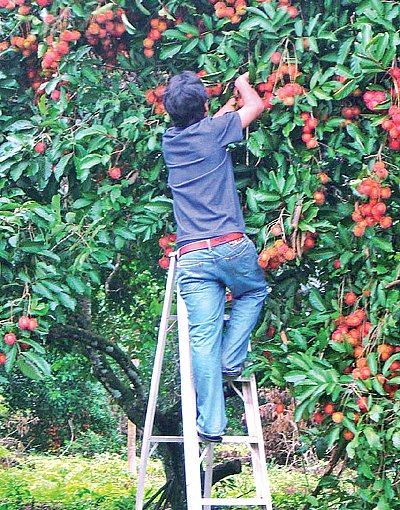Phuket Gardening: Rambutan – looks and tastes great

PHUKET: Of the glorious trees that grace our island gardens on Phuket, there are many small varieties that are considered ornamentals primarily on account of their decorative blossom.
These include the flame bean (brownea or sok phuang), the erythrina (thong lang or coral tree), the abutilon or Chinese lantern, and the orchid tree (bauhinia or chong ko).
Of course, a complete list would be much more extensive, but for my money, none of these should disappoint the gardener who wants both color and verdant foliage.
But there are many small trees grown here not so much for their looks as for their usefulness. Indeed, more traditional Thai gardens tended to emphasize such trees because of their obvious value as a food source.
Again, the choice is large, but the first tree to come to mind is the rambutan, or nephelium, a fruiting species that fits neatly into our size category since it reaches a height of only three or four meters.
The rambutan originates from the Malay peninsula, so it is perfectly at home and is extremely popular here. In fact, Thailand is the world’s leading producer of rambutans, especially the area around Surat Thani.
The distinctive reddish-green rounded fruit are covered with fleshy, pliable spines, and look a bit like sweet chestnuts. Rambutans suddenly appear in huge mounds at markets and on supermarket shelves at this time of the year. The rind peels off easily to reveal sweet, white, translucent flesh, sometimes slightly acidic, which encases a glossy brown seed. Delicious.
The tree itself is attractive enough to be popular in gardens. It has evergreen leaves, a rounded crown and blooms with white flower clusters. When it bears its abundant, colorful fruit, this tropical species looks good.
The floods this year have destroyed many commercial orchards in Thailand. As a consequence, the rambutan has not been as widely available as usual. Although rambutan trees can be grown from the large seeds inside each fruit, the fruit from trees grown from seeds tend to taste sour, thus seedlings are normally propagated from grafts.
However, it should be easy enough to find a hermaphroditic (both male and female) container plant in your local nursery in order to produce the goods.
So why not grow one yourself in your own patch? Your Thai neighbors will certainly be impressed.
Phuket Gardening is Phuket Gazette columnist Patrick Campbell’s feature of all things flora.
If you have a question or a garden that you would like featured, you can email Patrick Campbell here.
Keep checking our online Phuket Lifestyle pages for regular gardening features and tips.
— Patrick Campbell
Latest Thailand News
Follow The Thaiger on Google News:


























